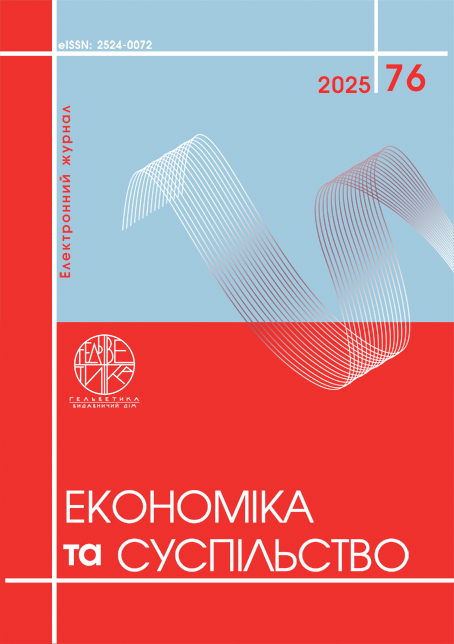HELIX MODELS AS A METHODOLOGICAL BASIS FOR ORGANISATIONAL AND ECONOMIC SUPPORT OF INNOVATIVE ENTREPRENEURSHIP
Abstract
The article substantiates the feasibility of utilising helical models (Triple, Quadruple, Quintuple Helix) as a methodological basis for innovative entrepreneurship's organisational and economic support. The text under discussion highlights the evolution of models from the triple interaction of universities, business, and the state to expanded forms involving civil society and the natural environment. The practical implementation of these strategies within the framework of European Smart Specialisation strategies and Horizon Europe, Interreg, and Erasmus+ programmes is analysed, confirming their effectiveness in transnational innovation projects. The formation of partnership structures, stakeholder interaction, and the socio-ecological dimensions of sustainable development are revealed. The proposal is for helical models to be considered a key tool in SME support policies in the context of European integration.
References
Carayannis E. G., Campbell D. F. J. «Mode 3» and «Quadruple Helix»: toward a 21st century fractal innovation ecosystem. International Journal of Technology Management. 2009. 46 (3-4). 201-234. DOI: https://doi.org/10.1504/IJTM.2009.023374
Carayannis E. G., Campbell D. F. J. Triple Helix, Quadruple Helix and Quintuple Helix and how do knowledge, innovation, and the environment relate to each other? International Journal of Social Ecology and Sustainable Development. 2010. 1(1). 41-69. DOI: http://dx.doi.org/10.4018/jsesd.2010010105
Cavallo A., Ghezzi A., Balocco R. (2018). Entrepreneurial ecosystem research: Present debates and future directions. International Entrepreneurship and Management Journal. 2018. 15(4). 1291-1321. DOI: https://doi.org/10.1016/j.techsoc.2023.102358
Etzkowitz H., Leydesdorff L. The dynamics of innovation: from National Systems and «Mode 2» to a Triple Helix of university–industry–government relations. Research Policy. 2000. 29 (2). 109-123. DOI: https://doi.org/10.1016/S0048-7333(99)00055-4
European Commission. (2021). Horizon Europe: Strategic Plan 2021–2024. URL: https://op.europa.eu/en/publication-detail/-/publication/3c6ffd74-8ac3-11eb-b85c-01aa75ed71a1
González-Martinez P., García-Pérez-De-Lema Doming, Castillo-Vergara M., Bent Hansen P. Determinants and performance of the quadruple helix model and the mediating role of civil society. Technology in Society, 2023. Volume 75. DOI: https://doi.org/10.1016/j.techsoc.2023.102358
HEInnovate. (2023). A guide for entrepreneurial higher education institutions. URL: https://www.heinnovate.eu/en
InnoHEIs Project – Interreg Europe. (2022). Improving Research and Innovation Infrastructure Performance. URL: https://projects2014-2020.interregeurope.eu/innoheis/
Leydesdorff L. The Triple Helix, Quadruple Helix, and an N-tuple of Helices: explanatory models for analyzing the knowledge-based economy? Journal of the Knowledge Economy. 2012. 3(1). 25-35. DOI: https://doi.org/10.1007/s13132-011-0049-4
SeeRRI Project. (2022). Building Self-Sustaining RRI Ecosystems. URL: https://seerri.eu/
Carayannis E. G., Campbell D. F. J. «Mode 3» and «Quadruple Helix»: toward a 21st century fractal innovation ecosystem. International Journal of Technology Management. 2009. 46 (3-4). 201-234. DOI: https://doi.org/10.1504/IJTM.2009.023374
Carayannis E. G., Campbell D. F. J. Triple Helix, Quadruple Helix and Quintuple Helix and how do knowledge, innovation, and the environment relate to each other? International Journal of Social Ecology and Sustainable Development. 2010. 1(1). 41-69. DOI: http://dx.doi.org/10.4018/jsesd.2010010105
Cavallo A., Ghezzi A., Balocco R. (2018). Entrepreneurial ecosystem research: Present debates and future directions. International Entrepreneurship and Management Journal. 2018. 15(4). 1291-1321. DOI: https://doi.org/10.1016/j.techsoc.2023.102358
Etzkowitz H., Leydesdorff L. The dynamics of innovation: from National Systems and «Mode 2» to a Triple Helix of university–industry–government relations. Research Policy. 2000. 29 (2). 109-123. DOI: https://doi.org/10.1016/S0048-7333(99)00055-4
European Commission. (2021). Horizon Europe: Strategic Plan 2021–2024. URL: https://op.europa.eu/en/publication-detail/-/publication/3c6ffd74-8ac3-11eb-b85c-01aa75ed71a1
González-Martinez P., García-Pérez-De-Lema Doming, Castillo-Vergara M., Bent Hansen P. Determinants and performance of the quadruple helix model and the mediating role of civil society. Technology in Society, 2023. Volume 75. DOI: https://doi.org/10.1016/j.techsoc.2023.102358
HEInnovate. (2023). A guide for entrepreneurial higher education institutions. URL: https://www.heinnovate.eu/en
InnoHEIs Project – Interreg Europe. (2022). Improving Research and Innovation Infrastructure Performance. URL: https://projects2014-2020.interregeurope.eu/innoheis/
Leydesdorff L. The Triple Helix, Quadruple Helix, and an N-tuple of Helices: explanatory models for analyzing the knowledge-based economy? Journal of the Knowledge Economy. 2012. 3(1). 25-35. DOI: https://doi.org/10.1007/s13132-011-0049-4
SeeRRI Project. (2022). Building Self-Sustaining RRI Ecosystems. URL: https://seerri.eu/

This work is licensed under a Creative Commons Attribution 4.0 International License.


